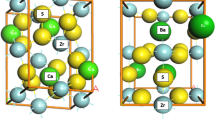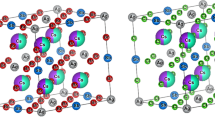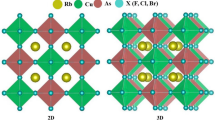Abstract
Context
A remarkable change in lattice parameters and bulk modulus is achieved by the suitable addition of Al (Al1-x Lax Sb) and In (Al1-x Inx Sb) atoms in the AlSb compound. Electronic responses like band structure, the total partial density of states, and the elemental density of states are thoroughly investigated. The computed values indicate that the binary compound AlSb is an indirect band gap and an optically inactive response. After increasing the doping concentrations (0.25, 0.5, 0.75) of La and In in AlSb, the band gap changes from indirect to direct nature. Hence, Al1-0.75 La0.25 Sb, Al1-0.50 La0.50 Sb, Al1-0.75 In0.25Sb, and Al1-0.50 In0.50Sb become optically active. The illustrious roles of Al-3p and In-4d states on the band gap and nonlinear responses of these compounds are extensively explored by the comparison between the computed results of ultra-soft and norm converging pseudopotentials. The excess specific heat (CV), enthalpy of mixing (Hm), and phonon dispersion curves resulting from the concentrations “x” are estimated in order to investigate the thermodynamic stability responses of the pristine and doped AlSb. The obtained CV and thermal coefficient statistics for Al1-x Lax Sb and Al1-x Inx Sb may be useful for a good mapping of experimental results and examining these compounds’ enharmonic responses. There is a valuable change in optical characteristics like dielectric functional, absorption, conductivity, and refractive index due to the addition of (La, In) impurities in AlSb. It is further observed that Al1-0.75 La0.25 Sb, Al1-0.50 La0.50 Sb, Al1-0.75 In0.25Sb, and Al1-0.50 In0.50Sb are significantly mechanically stable compared to pristine AlSb. The above results suggest that Al1-x Lax Sb and Al1-x Inx Sb are high-performance optical materials and can be promising potential candidates for optoelectronic applications.
Methods
The structural, electronic, mechanical, vibrational, and optical responses of the pure and doped Al1-0.75 La0.25 Sb, Al1-0.50 La0.50 Sb, Al1-0.75 In0.25Sb, and Al1-0.50 In0.50Sb are investigated, using Heydscuseria-Ernzerhof screened hybrid functional (HSEO6) and generalized gradient approximation (GGA) with norm-converging and ultra-soft pseudopotential techniques in the density functional theory.






Similar content being viewed by others
Data availability
Not applicable.
Abbreviations
- BS:
-
Band structure
- PDOS:
-
Partial density of state
- TDOS:
-
Total density of state
- EPDOS:
-
Elemental partial density of state
- DF:
-
Dielectric function
- RI:
-
Refractive index
References
Ivanov SV Kop’ev PS (2019) Type-II (AIGa) Sb/InAs Quantum Well Structures and Superlattices for Opto and Microelectronics Grown by Molecular Beam Epitaxy. In Antimonide-Related Strained-Layer Heterostructures pp 95–170
Sweeney SJ, Eales TD, Marko IP (2020) The physics of mid-infrared semiconductor materials and heterostructures. Mid-infrared Optoelectronics pp 3–56
Detchprohm T, Ryou JH, Li X, Dupuis RD (2019) Future aspects of MOCVD technology for epitaxial growth of semiconductors. Metalorganic Vapor Phase Epitaxy (MOVPE) Growth, Materials Properties, and Applications pp 507–548
Vadiee E (2019) Design, growth, and characterization of III-Sb and III-N materials for photovoltaic applications. Arizona State University
Baranets S et al (2022) On the effects of aliovalent substitutions in thermoelectric Zintl pnictides. varied polyanionic dimensionality and complex structural transformations─ the case of Sr3ZnP3 vs Sr3Al x Zn1–x P3. Chem Mater 34(9):4172–4185
Benchehima M et al (2018) Optoelectronic properties of aluminum bismuth antimony ternary alloys for optical telecommunication applications: first principles calculation. Comput Mater Sci 155:224–234
Moin M, Anwar AW, Ahmad MA, Ali A, Mehrunisa (2023) Computational Comparative Analysis of (Ag, In)-Doped LaAlO3 for Optoelectronic Application: A First-Principles Study. Journal of Electronic Materials pp 1–16
Hoat D, Silva JR, Blas AM (2018) First principles study on structural, electronic and optical properties of Ga1− xBxP ternary alloys (x= 0, 0.25, 0.5, 0.75 and 1). Phys Lett A 382(29):1942–1949
Rehman G et al (2016) Electronic band structures of the highly desirable III–V semiconductors: TB-mBJ DFT studies. J Electron Mater 45:3314–3323
Cuadrado R, Cerdá JI (2012) Fully relativistic pseudopotential formalism under an atomic orbital basis:spin–orbit splittings and magnetic anisotropies. Journal of Physics: Condensed Matter 24(8)
Shah D, Catellani A, Reddy H, Kinsey N, Shalaev V, Boltasseva A, Calzolari A (2018) Controlling the plasmonic properties of ultrathin TiN films at the atomic level. ACS Photonics 5(7):2816–2824
Hinkey RT et al (2011) Reflectance spectrum of plasmon waveguide interband cascade lasers and observation of the Berreman effect. J Appl Phys 110(4):043113
Sheerin E (2020) A study on the fabrication of seamless semiconducting and metallic nanowire networks and their applications for transparent electronics (Doctoral dissertation, Trinity College Dublin. School of Chemistry. Discipline of Chemistry)
Pohl J, Klein A, Albe K (2011) Role of copper interstitials in CuInSe 2: first-principles calculations. Phys Rev B 84(12):121201
Rommel SL (2000) Silicon-based tunnel diodes for integrated circuit applications. 2000: University of Delaware
Long X, Zhang S, Wang F, Liu Z (2020) A first-principle perspective on electronic nematicity in FeSe.npj Quantum Materials 5(1):50
Becker N, Dronskowski R (2016) A first-principles study on new high-pressure metastable polymorphs of MoO2. J Solid State Chem 237:404–410
Radiman S, Rusop M (2023) Investigation of structural and optical properties of In-doped AlSb nanostructures. Experimental and Theoretical Nanotech pp 49–76
Lucero MJ, Henderson TM, Scuseria GE (2012) Improved semiconductor lattice parameters and band gaps from a middle-range screened hybrid exchange functional. J Phys: Condens Matter 24(14):145504
Saßnick H-D, Cocchi C (2021) Electronic structure of cesium-based photocathode materials from density functional theory: performance of PBE, SCAN, and HSE06 functionals. Electron. Struct. 3(2):027001
Paier J (2016) Hybrid density functionals applied to complex solid catalysts: successes, limitations, and prospects. Catal Lett 146:861–885
Hoat D et al (2020) First principles insight into the structural, electronic, optical and thermodynamic properties of CsPb2Br 5 compound. Chem Phys 533:110704
Jaldurgam FF, Ahmad Z, Touati F (2021) Low-toxic, earth-abundant nanostructured materials for thermoelectric applications. Nanomater 11(4):895
Nabi S et al (2022) Correlation between structural, electronic, and optical response of Ga-doped AlSb for optoelectronic applications: a first principle study. Eur Phys J B 95(3):55
Charifi Z, Reshak AH, Baaziz H (2008) Phase transition of LaX (X= P, As, Sb and Bi) at high pressure: theoretical investigation of the structural and electronic properties. Solid State Commun. 148(3–4):139–144
Vaitheeswaran G, Kanchana V, Rajagopalan M (2002) Electronic and structural properties of LaSb and LaBi. Phys B 315(1–3):64–73
Zevalkink A et al (2011) Ca 3 AlSb 3: an inexpensive, non-toxic thermoelectric material for waste heat recovery. Energy Environ Sci 4(2):510–518
Fan X et al (2007) A direct first principles study on the structure and electronic properties of Be x Zn 1–x O. Appl Phys Lett 91(12):121121
Moussa R et al (2021) First principles calculation of the structural, electronic, optical and elastic properties of the cubic AlxGa1-xSb ternary alloy. Opt Mater 113:110850
Han G et al (2020) Effect of local strain energy to predict accurate phase diagram of III–V pseudobinary systems: case of Ga (As, Sb) and (In, Ga) As. J Phys D Appl Phys 54(4):045104
Annane F, Meradji H, Ghemid S, Bendjeddou H, Hassan FEH, Srivastava V, Khenata R (2020) Ab-initio study of ordered III–V antimony-based semiconductor alloys GaP _ 1-x Sb _ x and AlP _ 1-x Sb _ x GaP 1-x Sb x and A l P 1-x Sb x. Pramana 94:1–16
Pawar P, Singh S (2019) Structural and elastic behavior of aluminum pnictides with temperature effect. Int J Mod Phys B 33(30):1950365
Hor Y et al (2009) p-type Bi 2 Se 3 for topological insulator and low-temperature thermoelectric applications. Phys Rev B 79(19):195208
Annane F et al (2020) Ab-initio study of ordered III–V antimony-based semiconductor alloys GaP _ 1–x Sb _ x and AlP _ 1–x Sb _ x GaP 1–x Sb x and A l p 1–x Sb x. Pramana 94:1–16
Tütüncü HM, Bagci S, Srivastava G (2007) Electronic, elastic and phonon properties of the rock-salt LaSb and YSb. J Phys: Condens Matter 19(15):156207
Charifi Z et al (2022) Characterization of quaternary Heusler alloys CoFeYGe (Y= Ti, Cr) with respect to structural, electronic, magnetic, mechanical, and thermoelectric features. Int J Energy Res 46(10):13855–13873
Tretiakova K, Nec Y (2023) Separable solutions to nonlinear anisotropic diffusion equation in elliptic coordinates. Phil Trans R Soc A 381(2245):20220077
Liaw PK et al (2017) Computational design and performance prediction of creep-resistant ferritic superalloys. University of Tennessee, Knoxville, TN (United States)
Ledbetter HM, Reed RP (1973) Elastic properties of metals and alloys, I. Iron, nickel, and iron-nickel alloys. J Phys Chem Ref Data 2(3):531–618
Shao Y et al (2018) Design and mechanisms of asymmetric supercapacitors. Chem Rev 118(18):9233–9280
Pan Y et al (2015) Vacancy induced brittle-to-ductile transition of Nb5Si3 alloy from first-principles. Mater Des 86:259–265
Miceli MF et al (2023) A preliminary technology readiness assessment of morphing technology applied to case studies. Biomimetics 8(1):24
Vasconcelos AA et al (2023) Zeolites: a theoretical and practical approach with uses in (bio) chemical processes. Appl Sci 13(3):1897
Na S et al (2017) Effects of spatial heterogeneity and material anisotropy on the fracture pattern and macroscopic effective toughness of Mancos Shale in Brazilian tests. J Geophys Res: Solid Earth 122(8):6202–6230
Lee S et al (2014) Resonant bonding leads to low lattice thermal conductivity. Nat Commun 5(1):3525
Balakrishnan K, Alagarsamy S, Veerapandy V (2023) DFT investigations of structural stability and structure dependent physical behavior of SnO2 polymorphs. Physica B 654:414734
Thunis G, Hautier G, Rignanese GM, Charlier JC, Jacques P Electronic transport properties of thermoelectric Zintl compounds Ca 5 Al 2 Sb 6 and Ca 3 AlSb 3
Xiao P et al (2021) Revealing modification mechanism of Mg2Si in Sb modified Mg2Si/AZ91 composites and its effect on mechanical properties. J Alloy Compd 850:156877
Benchehima M et al (2017) Structural and optoelectronic properties of BxAl1-xSb ternary alloys: first principles calculations. Eur Phys J Appl Phys 77(3):30101
Amari S, Daoud S (2022) Structural phase transition, elastic constants and thermodynamic properties of TmAs: a DFT study. Comput. Condensed Matter 33:e00764
Babu KR et al (2011) Structural, thermodynamic and optical properties of MgF2 studied from first-principles theory. J Solid State Chem 184(2):343–350
Chowdhury A et al (2018) Predicted MAX phase Sc2InC: dynamical stability, vibrational and optical properties. Phys Status Solidi (b) 255(3):1700235
Babu KR, Lingam CB, Auluck S, Tewari SP, Vaitheeswaran G (2011) Structural, thermodynamic and optical properties of MgF2 studied from first-principles theory. J Solid State Chem 184(2):343–350
Lockwood D, Yu G, Rowell N (2005) Optical phonon frequencies and damping in AlAs, GaP, GaAs, InP, InAs and InSb studied by oblique incidence infrared spectroscopy. Solid State Commun 136(7):404–409
Nemiri O et al (2013) Structural, electronic, thermodynamic and thermal properties of zinc-blende InP, InAs and Their InAs x p 1–x ternary alloys via first principles calculations. Int J Mod Phys B 27(27):1350166
Daoud S, Bioud N, Saini P (2019) Finite temperature thermophysical properties of MgCu intermetallic compound from quasi-harmonic Debye model. J. Magnesium Alloys 7(2):335–344
Blanco M, Francisco E, Luana V (2004) GIBBS: isothermal-isobaric thermodynamics of solids from energy curves using a quasi-harmonic Debye model. Comput Phys Commun 158(1):57–72
Guo-Liang X et al (2009) First-principles calculation of elastic and thermodynamic properties of Ni2MnGa Heusler alloy. Chin Phys B 18(2):744
Vagnon F et al (2019) Effects of thermal treatment on physical and mechanical properties of Valdieri Marble-NW Italy. Int J Rock Mech Min Sci 116:75–86
Bokhan PA, Buchanov VV, Fateev NV, Kalugin MM, Kazaryan MA, Prokhorov AM, Zakrevskii DE (2006) Laser isotope separation in atomic vapor. John Wiley & Sons
Essick JM, Mather RT (1993) Characterization of a bulk semiconductor’s band gap via a near-absorption edge optical transmission experiment. Am J Phys 61(7):646–649
Beard MC, Ellingson RJ (2008) Multiple exciton generation in semiconductor nanocrystals: toward efficient solar energy conversion. Laser Photonics Rev 2(5):377–399
Robert CR (2013) Study of III-V nanostructures on GaP for lasing emission on Si (Doctoral dissertation, INSA de Rennes)
Nabi M, Gupta DC (2021) Small-band gap halide double perovskite for optoelectronic properties. Int J Energy Res 45(5):7222–7234
Ouadah O et al (2022) Probing the physical properties of boron nitride with randomly distributed vacancies: a promising semiconductor for optoelectronics. Solid State Commun 348:114744
Mochol I, Kirk JG (2013) Radiative damping and emission signatures of strong superluminal waves in pulsar winds. Astrophys J 776(1):40
Kana JK et al (2011) Thermally tunable optical constants of vanadium dioxide thin films measured by spectroscopic ellipsometry. Opt Commun 284(3):807–812
Poster DL et al (2021) Ultraviolet radiation technologies and healthcare-associated infections: standards and metrology needs. J Res Nat Inst Stand Technol 126:1–33
Author information
Authors and Affiliations
Contributions
Muhammad Moin, Dr. Abdul Waheed Anwar, and Dr. Ashfaq Ahmad researched about the material and worked on this project theoretically. Maria Yaseen, Dr. Usman Ilyas, Shafqat Nabi, and Anwar Ali assisted in graphical representations. Shahid Ali and Junaid Hassan edited the figures and tables of the manuscript.
Corresponding author
Ethics declarations
Ethics approval and consent to participate
Not applicable.
Consent for publication
Not applicable.
Competing interests
The authors declare no competing interests.
Additional information
Publisher's note
Springer Nature remains neutral with regard to jurisdictional claims in published maps and institutional affiliations.
Rights and permissions
Springer Nature or its licensor (e.g. a society or other partner) holds exclusive rights to this article under a publishing agreement with the author(s) or other rightsholder(s); author self-archiving of the accepted manuscript version of this article is solely governed by the terms of such publishing agreement and applicable law.
About this article
Cite this article
Moin, M., Anwar, A.W., Ahmad, M.A. et al. First-principle calculations to investigate structural, electronic, mechanical, optical, and thermodynamic features of promising (La, In)-doped AlSb for optoelectronic applications. J Mol Model 29, 219 (2023). https://doi.org/10.1007/s00894-023-05622-4
Received:
Accepted:
Published:
DOI: https://doi.org/10.1007/s00894-023-05622-4




